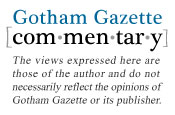New York Needs Real Reform, Not Higher Taxes

For the opposing point of view, see New York's Wealthiest Need to Sacrifice a Little Too by Kenneth Brynien of the New York State Public Employees Federation.
The Partnership for New York City is an organization of business leaders committed to promoting the economic interests of the city and state. We are not a knee-jerk opponent of tax increases.
On the contrary, the partnership was an early advocate of the Earned Income Tax Credit, which dramatically reduced the tax burden on New York’s working poor. We supported real estate tax increases to hire additional police and to raise teacher salaries. Most recently, we advocated for the imposition of the payroll tax on employers to help fund the Metropolitan Transportation Authority capital plan.

But the partnership opposes the "millionaires tax" as a solution to the state budget crisis for two primary reasons: first, this tax will do very little to address a budget shortfall that is projected to total $43 billion over the next three years if spending continues along historic trends; and, second, this tax is a poor substitute for the fundamental reforms that we all need to set our ship of state on a proper fiscal course.
It is also legitimate to worry about whether the millionaires tax will cause business owners, employers and investors to move out of the state, taking with them a lot of wealth and purchasing power that our local economies rely on. We already have seen this transpire in New York City, as more than 30 hedge funds have relocated to Connecticut.
Ninety percent of the taxpayers who would be captured by a millionaires tax reside in New York City, Long Island and Westchester. These communities carry the biggest portion of the state's tax burden, while simultaneously generating most of its new jobs and economic activity. Increasing taxes on the state's most prolific job generators so half-empty prisons and under-utilized health facilities in declining communities can remain open will not boost New York's revival.
The millionaires tax gives Albany an excuse to delay making the hard decisions required to reverse tax and spend policies that have resulted in an exodus from our state of 1.7 million people and 400,000 jobs over the past decade.
New York's two biggest areas of spending are Medicaid and education. Both are tough to scale back. But New York's Medicaid program has the most generous eligibility standards in the nation and provides patients with "Cadillac" health care plans. It also allows virtually any New Yorker to shelter income and assets in order to qualify for taxpayer-funded benefits during the last years of life. This is why our Medicaid costs are double the national average. It is not easy to cut spending on health care, but it is unfair to increase taxes on some New Yorkers so that others, who could well afford private health insurance, can shirk their responsibilities.
When it comes to education, 21 percent of the $52 billion state school budget goes for non-instructional purposes. The state has far too many local school districts, each insisting on running its own transportation system and maintaining a gaggle of administrative employees, consultants and turf prerogatives. New York's education spending is 67 percent higher than the national average, without a commensurate advantage in student outcomes. Districts resist consolidation, but their parochial concerns should not trump taxpayer interests.
New York's current deficit of $10 billion is not a short-term problem that was triggered by the recession. It is the result of government spending that has increased by 74 percent over the past decade, far outpacing the rate of economic or personal income growth.
Advocates for a millionaires tax argue that the state has a revenue problem, resulting from a financial crisis and global recession that depleted public coffers. But the current year's tax revenues are estimated to be only $100 million short of their all-time peak of $60.8 billion in 2007-08 and are projected to grow to $64.8 billion next year. In short, New York's fiscal crisis is a consequence of spending too much, not taxing too little.
Gov. Andrew Cuomo has called for fundamental reform of the programs and policies that have made New York the highest cost, highest taxed place to live and conduct business in America. He seems to have momentum to bring real change to Albany. He is trying to take the actions required to make our state competitive again. Adopting a millionaires tax at this time will only detract from those very promising efforts.
Kathryn Wylde is president and CEO of the Partnership for New York City.
New York's Wealthiest Need to Sacrifice a Little Too

For the opposing point of view, see New York Needs Real Reform, Not Higher Taxes by Kathryn Wylde of the Partnership for New York City.
New York is suffering a fiscal crisis as a direct result of greedy financial institutions. Billionaire financial wizards caused this mess, and it is not too much to ask for them to pitch in a few pennies on the dollar to help clean it up. That is why the Public Employees Federation, many other unions and advocates for education and social services, strongly support the extension of the so-called "millionaires tax."
In the mid-1990s New York, like the rest of the world was in the middle of a fantastic economic expansion. Some thought it would last forever and the revenues generated by Wall Street would never stop flowing. Based on this assumption New York commenced cutting taxes. What a time it was! You could cut taxes and still keep spending at the same level or even increase it.

This expansion, as it turned out, was not real. It was based on one financial scheme after another: first the tech bubble, then WorldCom and Enron and finally the housing bubble. Now we are finally dealing with the decisions made in the mid-1990s based on those faulty assumptions. New York gave away billions in tax revenues thinking the party would never end. According to the Fiscal Policy Institute, if we had the same tax structure now that we had in the mid-1990s, we would have an additional $13.5 billion in revenues. Instead of talking about our devastating fiscal crisis we would be asking, what can we do with the surplus?
New York's leaders have stated their plans for how to deal with this new reality. They talk a lot about "sharing the pain" in Albany these days. Unfortunately, there is a definitional problem because apparently sharing doesn’t mean what I thought it did. The governor has proposed a budgetthat cuts spending for state agencies by 10 percent. He has threatened my members with thousands of layoffs unless we make concessions worth hundreds of millions of dollars. Yet wealthy New Yorkers are going to realize a tax cut on Jan. 1. Either it pains the wealthy to get tax cuts or there is no sharing of the pain here.
While the leaders wrestle with how a tax cut equals pain the voters are not so confused. When asked if the tax on those making more than $200,000 should be allowed to expire at the end of the year almost 65 percent of voters said no.
Unfortunately, for some of our elected officials the will of the voters matters little. Gov. Andrew Cuomo has stated in no uncertain terms that he will not extend the surcharge on the wealthiest New Yorkers. The state Senate leadership has made similar statements. Only the Assembly has stood up against the moneyed interests in New York and passed a bill that, if enacted, would continue the surcharge on the wealthy. The Assembly's tax plan extends the surcharge for only one year and modifies the current surcharge by raising the income levels affected. Extending the existing surcharge would raise $1 billion this fiscal year and $4 billion next year. The Assembly proposal raises $750 million this fiscal year and $3.45 next fiscal year.
So the voters are being ignored. The unions, the students, the advocates for the poor and thousands of others who have protested in Albany are being ignored. Who is it that has the ear of the leaders in Albany? Those who "vote" with large amounts of cash are being heard loud and clear.
New York's wealthiest are joining forces and pitching in not for the betterment of New York but for the fattening of their wallets. Yes New York's greediest are putting up $10 million and more to fight against the rest of us so they can keep their millions and billions.
Well, it must be that New York’s wealthiest are being buried in taxes and need a break. As it turns out that is not the case. Right now, the wealthiest New Yorker’s, the top one percent whose households make more than $633,000 a year, pay 8.4 percent of their income in state and local property taxes. Gov. Cuomo and the State Senate want to cut the top one percent's tax burden to 7.2 percent by allowing New York's top two tax brackets to expire.
If the temporary tax rates were made permanent, New York would be able to balance its budget with a lot less damage to the economy. It would still be able to devote $1 billion a year, starting next year, to helping the people who really need tax relief -- those middle and lower income families being squeezed out of their homes by high property taxes.
New York is a great state and a great place to live and raise a family. Every New Yorker should be willing to do whatever it takes to help us keep New York great. I have said repeatedly that we, the members of the Public Employees Federation, are willing to make sacrifices but we are not willing to be sacrificed. We will do our part but we fully expect that all New Yorkers will do their part too.
Kenneth Brynien is president of the New York State Public Employees Federation.
Behind Bloomberg's Budget Surpluses

Given a 10th chance to continue his serial budget cuts, Mayor Michael Bloomberg, at least on the surface, pulled back. The mayor's preliminary budget for fiscal year 2012 and four-year financial plan, released Feb. 17, is something of a surprise. It is a remarkably cool, even complacent document. No big new cuts. Less anti-labor rhetoric. Little sense of crisis. What happened?
One answer is that the most severe cuts on the table -- eliminating over 6,000 teaching positions, cutting services to seniors, youth, libraries, etc. -- were already built into the ninth package of cuts, which came in the mayor's November budget modification. Absent any new action by the mayor or council, those cuts will take effect in 2012.
A second answer is that a huge increase in new (Wall Street-driven) tax revenue and other new budget-balancing resources since November makes the fiscal outlook -- at least for next year -- much more positive. In fact, the news is so good that the mayor -- given his serial insistence on cutbacks – may not, for once, want to stir the political waters. After all, one might ask, why not use those new resources to rescind the November cuts?
The mayor’s own interest seems to be to underscore the dramatic contrast of his fiscal plan with the budget hysteria and uncertainty at federal and state levels. As conservative leaders from both political parties in Congress and states across the nation outdo each other with daily doomsday scenarios, the mayor has an irresistible opportunity to remind the political world: "During the economic boom years, we did not spend all of our resources each and every year as many others did."
The Mayor's Power
The most fascinating and problematic aspect of the preliminary budget is the sheer scale of mayoral discretionary powers at play, powers that leave the City Council playing catch-up and squashing any sense of checks and balances in the city’s budget process. For instance, the mayor, who alone determines projected revenues, reports in the preliminary budget -- just three months after the November modification -- that the city will actually pull in over $2.1 billion more in tax revenues in the next 17 months than it anticipated in November. The Independent Budget Office had been closer to the mark than the mayor; it noted in mid December that tax revenues would be over $1.5 billion higher than the November plan suggested.
The lower revenue forecast in the November modification enabled the mayor to justify his budget cuts: $1.6 billion over the next 17 months. Also, moving the cuts into November, as he has done several times, gives the mayor a political advantage because in mid-year the council has less clout and the public less access to the budget process.
Another discretionary power in full display this fiscal year is the use of large, generally obscure reserve funds. The November modification included, for example, a $1.1 billion drawdown from the city's Retiree Health Benefits Trust Fund during 2011 and 2012, a reserve fund ostensibly set up to meet long-term liabilities.
Flash forward to the preliminary budget, which includes two more big drawdowns. As he did last year, the mayor takes $500 million from a "prior year payables fund," money set aside to pay bills from earlier years but no longer needed. He also uses $200 million from a general reserve fund that would otherwise be used for emergencies.
Other budget-balancing changes include refinancing of city debt and re-estimates of expenses. Re-financings in fiscal 2011 and 2012 will save over $600 million. Re-estimates of projected spending on Medicaid, health insurance and legal claims against the city add up to over $600 million in reduced spending.
In other words, in just three months, some $4 billion in new budget-balancing resources have surfaced. The new revenues more than offset new expenses of over $700 million during the next 17 months and some $1.4 billion in lost state aid. The net result is the November modification’s projected 2012 deficit of $2.4 billion is knocked down to $600 million in the preliminary budget.
Getting the state to solve city budget deficits is a common tactic in preliminary budgets, of course, but this year it seems an unusually small request: $200 million from an "equitable reduction" of state revenue sharing (usually about $300 million, but entirely eliminated in the governor’s budget); $200 million from additional state educational aid; and $200 million from "moderate reform" of existing police and firefighter pension benefits, targeting the annual $12,000 bonus given to retired police officers and firefighters that costs $600 million a year, according to the New York Post . The Post also pointed out that the mayor himself expanded the bonus benefit to some 6,900 current officers and firefighters as an incentive to defer retirements.
Budget Surpluses and Budget Cuts
One of the less recognized aims of such discretionary changes is building up the current-year budget surplus. In spite of all the gloom and doom in last June’s adopted budget and the November modification, the city is now on target to have a $3.2 billion surplus at the end of this fiscal year, ending June 30. With almost four months left -- if previous years are any indication -- that $3.2 billion will grow bigger. (Last year’s surplus was $3.6 billion.)
The teachers union and other opponents of the mayor's spending cuts have said he should use this surplus to avoid layoffs. However, the rollover of the surplus into the next fiscal year makes it the single biggest component of the 2012 balanced budget.
No question, this is the ultimate achievement of the mayor and his Office of Management and Budget. They do not simply balance a budget; they repeatedly do budgets with billion-dollar surpluses. Where else in local, state, and federal governments does such a thing happen?
This leaves one other question: Is it good for New Yorkers? Examining some of the detail in the preliminary budget suggests that the year-round focus on cutting services to build up surpluses does not work equitably or permit long-term planning. Worse yet, it has encouraged a kind of bloodless budget making. In spite of billion-dollar surpluses, recent budgets, like this preliminary budget, lack any sense of direction, any acknowledgment of distress in the city.
Take the $1.6 billion in 2011/2012 cuts now being implemented. The 2011 cuts in uniformed services average less than 1 percent (0.85 percent). Cuts in the four uniformed serves in 2012 average 2.3 percent, while the cuts in public education are 4 percent, with CUNY taking an 8 percent hit, and health and welfare agencies averaging 6.24 percent. Other mayoral agencies -- including housing, parks, libraries, cultural affairs, and transportation -- in 2012 will be cut, an average of 8.32 percent.
More specifically, the $4.25 billion police department has $43 million in projected budget savings in fiscal 2011, but largely because of big new overtime costs has added $162 million in new expenses in 2011 since the budget was adopted last June. Not one uniformed officer position will be cut. Yet if the mayor actually follows though on his proposal -- and is not just bluffing -- 6,166 teaching positions will be eliminated, 4,666 through layoffs.
The fire department finds $7.9 millions in new savings but adds over $50 million in new expenses, much of it from new overtime expenses. The corrections department makes about $5 million in savings in 2011, but adds $41 million in new 2011 expenses. The sanitation department, where 200 uniformed staff positions are eliminated in 2011 – and another 65 in 2012 – nevertheless has added $80 million in new expenses in 2011 and saved only $25,130 from planned spending during the year.
Reporting on Budget Cuts
On Feb. 25, the mayor released the preliminary mayor's management report on the first four months of the current 2011 fiscal year. Although Bloomberg has been trying for years to eliminate the charter-mandated preliminary report and provides no personal or agency overview, it occasionally surfaces important information.
For instance, the human services contract budget in the Department for the Aging during the first four months of fiscal 2011 was $65.6 million, or 16 percent lower than for the same period a year ago. That helps explain why the hours of home care services decreased by 29 percent, the number of meals served at senior centers declined by 7 percent and meals delivered to seniors at home fell by 3 percent.
In the Department of Youth and Community Development the four-month human services contract budget was $79.9 million, down 17 percent from the previous year. One program for adult basic education and English for speakers of other languages lost 31 percent of its participants. Summer job participants dropped by 32 percent in fiscal 2011 -- a decrease the city blamed on federal and state cuts -- from 52,255 to 35,612.
At the Administration for Children's Services, the number of children receiving contracted preventive services fell from 30,047 to 23,581 in the past year as the number of abuse/neglect reports and substantiated reports rose.
Budget impacts in education have proved hardest to document. Perhaps prompted by widespread criticism of both the mayor's education program and the $571 million education cut in the November plan's $1.6 billion deficit plan, the preliminary budget highlights the city’s 132 percent increase in city-funded education spending, from $5.9 billion in 2002 to a projected $13.6 billion in 2012.
It's as if the mayor is saying, I've spent a lot on education, so a loss of 6,000 teachers is no big thing. But the management report – however cryptically – suggests a system in trouble
One result of nine rounds of budget cuts, for instance, is increased class size. According to the new preliminary management report, class size in kindergarten through grade eight has increased from 24.1 per class last year on average to 24.9 this year. Class size in the lowest grades -- kindergarten through three -- rose from 22.1 on average to 23.0 during the same period.
Beyond that, on the key questions about educational achievement, the PMMR offers confusion. School reading and math scores, which the mayor has made his ultimate accountability measure, have become essentially useless. Shifts in both state and city testing standards make any comparison over time impossible. For instance, the percentage of students in grades three to eight meeting or exceeding standards in English language arts goes like this: 57.6 percent in 2008, 68.8 percent in 2009, and 42.4 percent in 2010.
The report's rather hapless answer to this apparent failure to provide better basic education is the state's "recalibration" of the scores, which "does not necessarily mean that student performance declined; rather, the students of New York City are now being held to a higher standard." That seems like a soft result for a $7.7 billion increase in city education spending over the past nine years.
Little New Revenue
The preliminary budget offers few new revenues produces and those it does provide are small, only 10 percent of the $1.6 billion in cuts.
It proposes no new taxes. The biggest revenue producers are increases in the cost of for parking at a meter -- slated to bring in $14 million in 2012 in upper Manhattan and the outer boroughs and $12 million from the rest of Manhattan. New hires in the Finance Department will add $27 million in new tax revenues in 2012 by collecting more money owed the city. The parks department will get $4 million from new and higher fees, and the building department about $4 million in 2011 and 2012 in new fees.
The mayor's overall emphasis on service cuts and no new taxes mirrors, of course, the general national politics. Neither the president, Congress, nor most state governors, want to look at new taxes, let alone progressive taxes.
Interestingly, just as President Barack Obama and both houses of Congress have ignored the budget-balancing recommendations of the president's deficit-reduction commission, Bloomberg and the City Council have ignored, among other options, the annual recommendations for new budget choices in the Independent Budget Office's excellent Budget Options report. It provides an array of money-saving management and progressive tax ideas that would provide hundreds of millions of dollars that, through shared sacrifices, would preclude the kinds of cuts the preliminary budget promotes.
What ultimately distinguishes the mayor from other budget-makers, however, is not simply his skill in balancing a year's budget, but his use of extraordinary discretionary powers to make budget-cutting a year-round goal, building surpluses each year in order to build new surpluses for the next year.
However well that goal plays in the mayor's national political conversations, he might also want to consider another Preliminary Mayor's Management Report finding: Some 1.8 million New Yorkers -- over 21 percent of city residents -- now receive federal food stamps, an increase of 44 percent in the past three years and 11 percent in the past year alone. The city seems to be suffering in ways not acknowledged in either the preliminary budget or the management report.
Glenn Pasanen, who teaches political science at Lehman College, has been in charge of Gotham Gazette's finance topic page since 2001.




